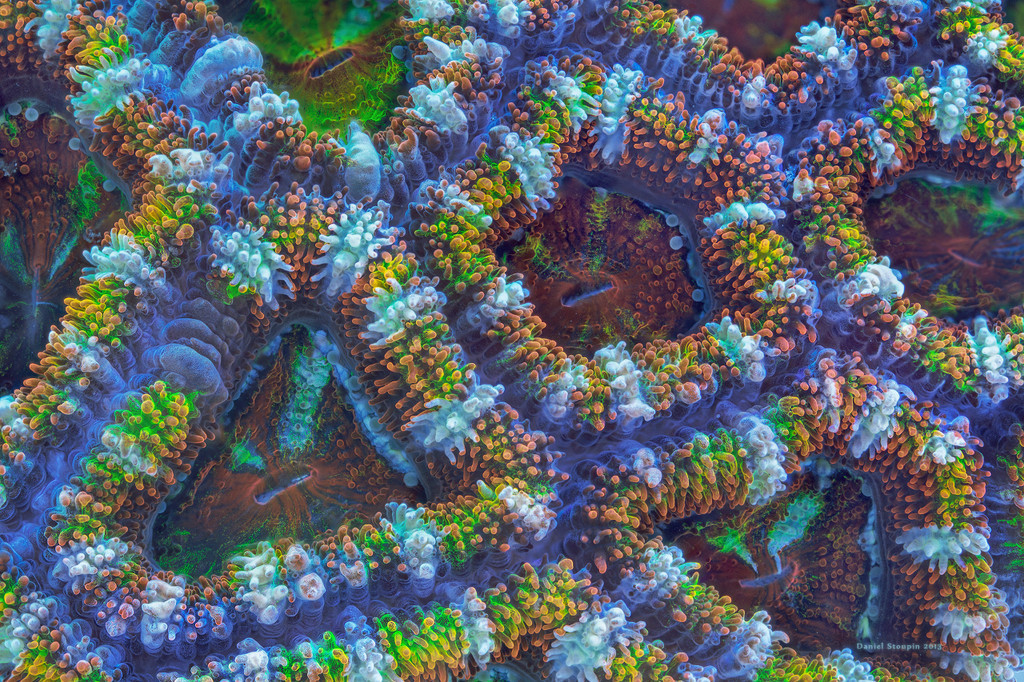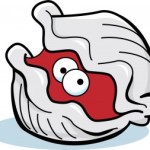Daniel Stoupin’s message is simple: Please care for the Great Barrier Reef. His film, on the other hand, shows the incredible complexity of the animals that live there. This video has left me completely in awe.
Below, I’ve tried to provide information of the animals featured in the video. In some cases, I don’t know. For specific IDs I’ve looked to Daniel’s website for help. Daniel was also kind enough to check them for me. That being said, there are still some unknowns. I encourage others to chime in with more information in the comment section. I’ll update this post as new information becomes available.
As for the vivid colors, Daniel uses full spectrum light (shifted to the blue) to bring out the animal’s natural fluorescence. Beautiful.
 0:01-0:15 — the stunning crown of a filter-feeding annelid worm. Worms like this live in tubes or burrows, with only their delicate feeding structures exposed. Once a food particle is ensnared, cellular hairs guide it to the central mouth. *Update* According to Smithsonian zoologist Allen G. Collins, it’s probably a sabellid.
0:01-0:15 — the stunning crown of a filter-feeding annelid worm. Worms like this live in tubes or burrows, with only their delicate feeding structures exposed. Once a food particle is ensnared, cellular hairs guide it to the central mouth. *Update* According to Smithsonian zoologist Allen G. Collins, it’s probably a sabellid.
 0:22-0:45 — a soft coral colony. Known as “octocorals”, soft corals are different from the more familiar hard corals in that they don’t have a hard skeleton. Instead, they use a complex mesh of biomolecules to shape the colony. Soft coral polyps also have 8 tentacles, hence the name “octocoral.” *Update* Allen G. Collins thinks this is a Heteroxenia.
0:22-0:45 — a soft coral colony. Known as “octocorals”, soft corals are different from the more familiar hard corals in that they don’t have a hard skeleton. Instead, they use a complex mesh of biomolecules to shape the colony. Soft coral polyps also have 8 tentacles, hence the name “octocoral.” *Update* Allen G. Collins thinks this is a Heteroxenia.
 0:46-0:55 — This is a close-up of a mushroom coral (Discosoma sp). This looks like a solitary species. Solitary corals are, well, exactly that, single coral polyps that live alone, not as part of a colony. They can be quite large, I often see solitary corals about the size of a human hand. *Update* Allen G. Collins suggests this may be a corallimorph, a relative of corals.
0:46-0:55 — This is a close-up of a mushroom coral (Discosoma sp). This looks like a solitary species. Solitary corals are, well, exactly that, single coral polyps that live alone, not as part of a colony. They can be quite large, I often see solitary corals about the size of a human hand. *Update* Allen G. Collins suggests this may be a corallimorph, a relative of corals.
 0:56-1:01 — Favites pentagona, known by the shamelessly amusing common name of “red and green war coral”.
0:56-1:01 — Favites pentagona, known by the shamelessly amusing common name of “red and green war coral”.
 1:01-1:04 — This is a species of hermaphroditic cup coral, called Acanthastrea lordhowensis.
1:01-1:04 — This is a species of hermaphroditic cup coral, called Acanthastrea lordhowensis.
 1:05-1:20 — A polyp digging its way out of sediment. Amazing! I think this is, again, a solitary coral polyp.
1:05-1:20 — A polyp digging its way out of sediment. Amazing! I think this is, again, a solitary coral polyp.
 1:20-1:35 — no idea, but I want one.
1:20-1:35 — no idea, but I want one.
 1:41-1:51 — A little coral polyp opening up at night. According to Daniel it’s the same species as above.
1:41-1:51 — A little coral polyp opening up at night. According to Daniel it’s the same species as above.
1:52-2:02:01 — DEAR GAWD! Is that the excurrent canal of a sponge?! I can’t think of what else it would be, but at the same time I kinda don’t believe it. Sponges (those animals that look like rocks and gave us the dish sponge) have a network of tiny pores along their surface. These pores suck in water and the animal then filters out food particles. All the water eventually leaves the sponge through a large opening, or excurrent canal. But….I had no idea they moved…
 2:02-2:26 — ok, all these look like sponges, but I’m still finding it hard to believe. *Update* Yep, they’re sponges. According to Daniel, “Sponges regulate water flow by means of adjusting the diameter of their canals (in addition to speed of flagella beating). You can actually see individual cells working to make the seal.”
2:02-2:26 — ok, all these look like sponges, but I’m still finding it hard to believe. *Update* Yep, they’re sponges. According to Daniel, “Sponges regulate water flow by means of adjusting the diameter of their canals (in addition to speed of flagella beating). You can actually see individual cells working to make the seal.”
 2:27-2:33 — little coral polyps. According to Daniel it’s a Goniopora.
2:27-2:33 — little coral polyps. According to Daniel it’s a Goniopora.
 2:34-2:38 — I’m blown away by all the colors here. The fluorescence is really incredible. More Acanthastrea lordhowensis polyps (starry cup coral).
2:34-2:38 — I’m blown away by all the colors here. The fluorescence is really incredible. More Acanthastrea lordhowensis polyps (starry cup coral).
 2:38-2:44 — According to Daniel, it’s a Favia.
2:38-2:44 — According to Daniel, it’s a Favia.
 2:45-2:52 — A “rainbow Lobophyllia.” Seems like a good name…
2:45-2:52 — A “rainbow Lobophyllia.” Seems like a good name…
 2:53-3:00 — A purple zoanthid colony. Zoanthids are similar to corals, widely distributed, and popular with photographers and aquarists. Surprisingly, from a scientific perspective, we know very little about them.
2:53-3:00 — A purple zoanthid colony. Zoanthids are similar to corals, widely distributed, and popular with photographers and aquarists. Surprisingly, from a scientific perspective, we know very little about them.
 3:00-3:02 — hard coral polyps of some kind. *Update* According to commenter Dr_Yak, it may be a Platygyra.
3:00-3:02 — hard coral polyps of some kind. *Update* According to commenter Dr_Yak, it may be a Platygyra.
 3:12 — more soft corals, known as octocorals.
3:12 — more soft corals, known as octocorals.
 3:13-3:19 — A sea urchin! The yellow structures are spines. The brown worm-like structures with white tips are tube feet. Urchins use tube feet to move around, stick to things, and even sense light! The little blue structures are called pedicellariae. Pedicellariae are like little claws the urchin uses to grab onto rocks or fend off invaders. In some species they can be venomous.
3:13-3:19 — A sea urchin! The yellow structures are spines. The brown worm-like structures with white tips are tube feet. Urchins use tube feet to move around, stick to things, and even sense light! The little blue structures are called pedicellariae. Pedicellariae are like little claws the urchin uses to grab onto rocks or fend off invaders. In some species they can be venomous.
And now I’m going to watch it again. And again. And again.
For more amazing images and video, check out Daniel’s website: MicroWorldsPhotography.com









3:00-:302 Looks like a Platygyra to me – submeandriod, well developed septae. Not 100% sure though.
Absolutely gorgeous video and microscopy!
Also regarding the GBR have a look at:
http://www.theguardian.com/environment/ng-interactive/2014/mar/great-barrier-reef-obituary
Very good feature with some very sobering take home messages…